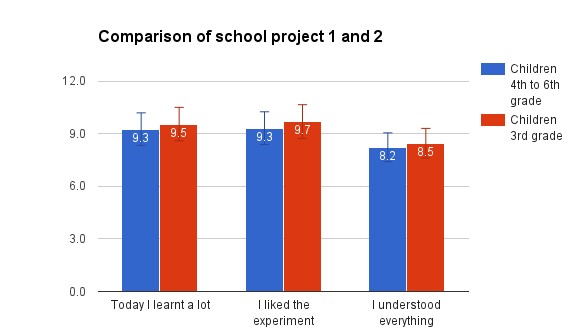Team:ETH Zurich/Practices/Education
- Project
- Modeling
- Lab
- Human
Practices - Parts
- About Us
Education
We believe that educating the general public is a fundamental part of being a scientist. Scientific education should start in schools, stimulating children's curiosity and seeding an enthusiasm for discovering the world around them. Since today's children will be tomorrow's scientists and policy makers, our first goal was to contribute towards the teaching of basic science.
Summary
In summary, we learned that:
- Children are enthusiastic about science and willing to try new things if they have the opportunity.
- Communicating concepts to people who have no previous backround in science is a challenge. It made us go back through all our knowledge to the basics and seeing them with a new insight.
What we did
Overview
Children like fun and interactive activities, making them more eager to get involved and explore. With this in mind, we designed a one and a half hour lecture with a brief introduction to the theory of cells and DNA, followed by a practical session of DNA extraction from strawberries. Finally, we drew some conclusions from the experiment, and also explained some funny biological facts related to cells and DNA.
Methodology
We presented our lecture to three groups of children at two different schools. The main challenge was to adapt the content of the lecture to their age group (ranging from 9 to 12 years of age). Hardly any of them had heard about genes or cells before, so we simplified the concepts as much as possible without losing perspective. We used lots of visuals, a light microscope provided by the school, and we made some long paper-DNA strands with colorful "ACTG" letters which we could fold into a tiny space! This way, children were able to comprehend how DNA can fold into a small space such as a cell.
What we got
After doing the experiment, we asked the children to complete a survey to determine what they had learned from the experience and to judge if this experience had sparked an interest in science. The survey was in the form of three quotes, where the children had to decide how well the quotes described their experience on a scale ranging from 1 (I absolutely disagree) to 10 (I completely agree).
In addition, we tried to determine what aspect of the lesson was the most impressive for them by asking what part of the lesson they would tell their friends about later.
Overall, the children rated the lesson very highly and we are certain that this experience will lead some of them to seriously consider a career in the biological sciences in the future!






































